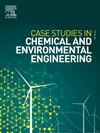在最佳实验室条件下光生物反应器中微藻生产生物柴油(FAME)的分析
Q1 Environmental Science
Case Studies in Chemical and Environmental Engineering
Pub Date : 2024-12-28
DOI:10.1016/j.cscee.2024.101087
引用次数: 0
摘要
从微藻中提取的第三代生物燃料提供了一种可持续的解决方案,可以满足不断增长的能源需求,同时最大限度地减少与粮食资源的竞争,并减少温室气体排放。微藻是一种极具生产生物柴油潜力的原料。本研究研究了氮剥夺对小球藻(一种生产生物柴油的有前途的微藻)脂质积累的影响,确定了生产过程中的最佳条件,并在生物反应器中比较这些控制条件和环境条件下的生物量和脂质产量。结果表明,氮剥夺使小球藻的脂质含量提高了7.7%,表明了氮剥夺对生物柴油的促进作用。采用因子设计确定了生产生物柴油的最佳条件,包括温度(24.74°C)、pH(8.25)和光照强度(6600 lux)。在优化的实验室条件(pH 8.25,光照强度6600 lux,温度24.74℃)下,生物柴油的最大产率为79%。在阿雷基帕的环境条件下,生物柴油的脂质含量达到21.21%,与实验室条件下的21.24%相当。环境和实验室条件产生了类似的生物柴油产量,突出了室外生产的可行性。本文章由计算机程序翻译,如有差异,请以英文原文为准。
Analysis of biodiesel production (FAME) from microalgae Chorella SP. In a photobioreactor under optimum laboratory conditions
Third-generation biofuels derived from microalgae offer a sustainable solution to meet rising energy demands while minimizing competition with food resources and reducing greenhouse gas emissions. Microalgae are a raw material with high potential for their use in the production of biodiesel. This study investigates the effect of nitrogen deprivation on lipid accumulation in Chlorella sp., a promising microalga for biodiesel production, identifying in the process the optimal conditions for production, being the main goal to compare biomass and lipid production between these controlled conditions and environmental ones using a bioreactor. The results showed that nitrogen deprivation increased lipid content by 7.7 % in Chlorella sp., demonstrating its potential for biodiesel enhancement. The optimal conditions for biodiesel production, including temperature (24.74 °C), pH (8.25), and light intensity (6600 lux), were identified using factorial design. Under optimized laboratory conditions (pH 8.25, light intensity 6600 lux, temperature 24.74 °C), maximum biodiesel yield was achieved at 79 %. Under environmental conditions in Arequipa, biodiesel production achieved 21.21 % lipid content, demonstrating comparable efficiency to laboratory conditions (21.24 %). Environmental and laboratory conditions yielded similar biodiesel outputs, highlighting the feasibility of outdoor production.
求助全文
通过发布文献求助,成功后即可免费获取论文全文。
去求助
来源期刊

Case Studies in Chemical and Environmental Engineering
Engineering-Engineering (miscellaneous)
CiteScore
9.20
自引率
0.00%
发文量
103
审稿时长
40 days
 求助内容:
求助内容: 应助结果提醒方式:
应助结果提醒方式:


